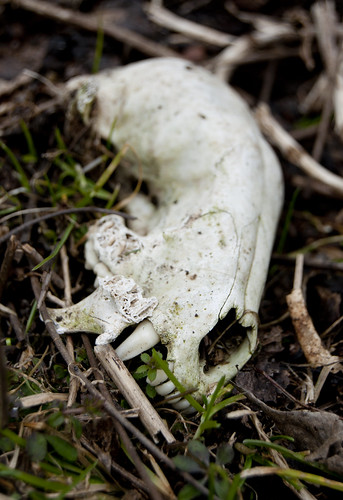This skull belongs to a sub-adult raccoon. All of its adult teeth had grown in at the time of its death, but the sutures on the skull are not fused and the skull itself is quite small, with a length of 4.25 inches. I found this specimen in March of 2011 at the Matthaei Botanical Gardens in Ann Arbor, and originally described it in this post.
This second skull came from an adult male. It's larger than the juvenile, and the largest raccoon skull in my collection, measuring about 5 inches in length. I found it in November of 2010, also at the Matthaei Botanical Gardens, and its corresponding blog post can be read here.
The third skull pictured came from an extraordinarily old adult male raccoon. The sutures are completely fused, including the ones on the (visibly short) rostrum, and the sagittal crest is quite pronounced. In addition, his canine teeth were dull and broken at the time of his death. This skull likely belonged to a rather stocky individual, as it measures 4.5 inches. I found this skull in 1998 (or thereabouts) in Livingston County, MI. The skeleton had been sitting out in the sun for a very long time, explaining this skull's flaky, bleached appearance.
I own a few other raccoon skulls as well, including this one that I neglected to write about:
This skull was found in March of 2011 on a well-used deer trail at the Matthaei Botanical Gardens. The bones had been trampled by the hooves of many deer; they were broken and splintered, and some had been pressed deep into the earth.
Why own so many skulls from the same species? Well, for one, it's quite enjoyable to compare their differences:
 |
| click for larger view |
When compared next to one another, the differences between the juvenile and adult raccoon become more apparent. Smaller size aside, note the petite, delicate shape of the juvenile's skull.
 |
| click for larger view |
Different too are the skulls of the adult raccoon and the old raccoon. We all have learned that no two humans are alike — well, the same applies to other animals, too! Raccoons, in particular, have quite a bit of genetic diversity. Some are very large, and others not so much; some have long tails, and others have stubby tails; some have chocolate-brown coats, others have gray coats, and still others are "blonde". This genetic diversity can be observed in their skulls and skeletons, as well — and it's seen here, with the shorter, stockier skull shape of the old raccoon.
 |
| click for larger view |
Lastly, here are all three raccoon skulls seen from above, showcasing their sagittal crests — or lack thereof. (The old raccoon is on the left, the adult in the middle, and the sub-adult on the right.)
From these photographs, it's quite possible you've noticed that I don't whiten my skulls — or at least, not these specimens. There are a few reasons for this, the first being that, quite honestly, I like skulls looking a little bit dirty! As professional as whitened skulls are, I find their level of near-glowing whiteness a little distracting. In addition, the color of a skull can sometimes tell you a lot about where it was found, when the animal died, and how it decomposed. For example, the juvenile raccoon was found in the floodplain of a small creek, caked in dried dirt. As a result, the skull is stained a brownish color. That visual information would be lost if I were to soak it in a bath of peroxide!
The next collection post will feature a few members of Mustelidae — the weasel family! If you've got any requests regarding angles or close-up shots of these skulls, or the information discussed, let me know.








Oh, that was interesting. We don't have raccooons here in our area (thanks god xD). The skull of the methusalem lookes very special. And by the way, I like "dirty" skulls, too.
ReplyDelete